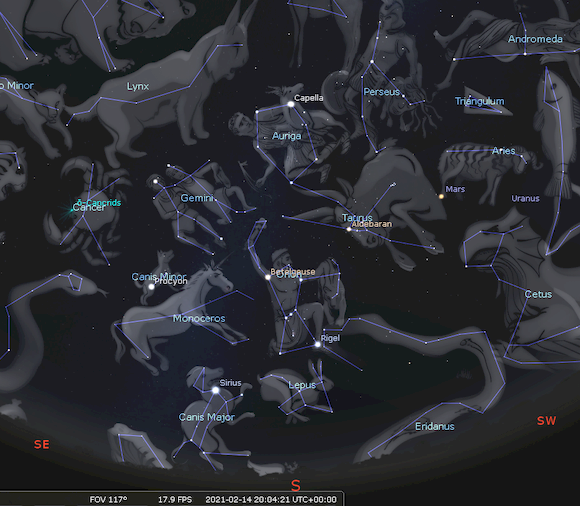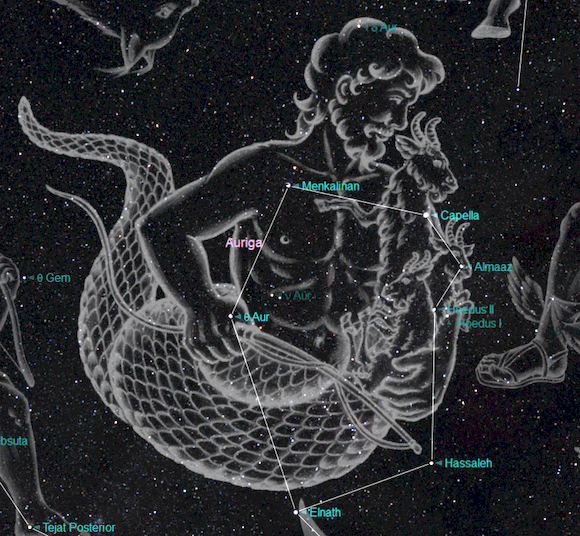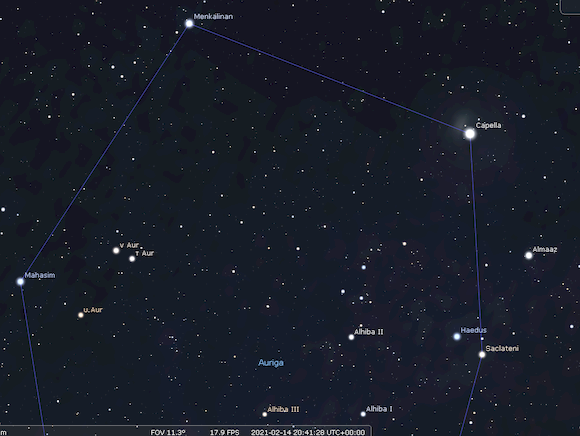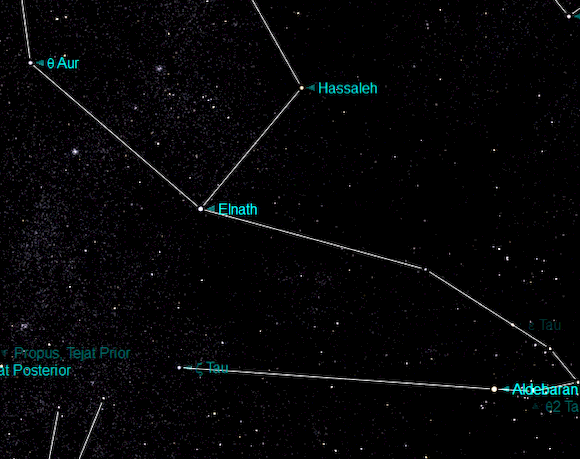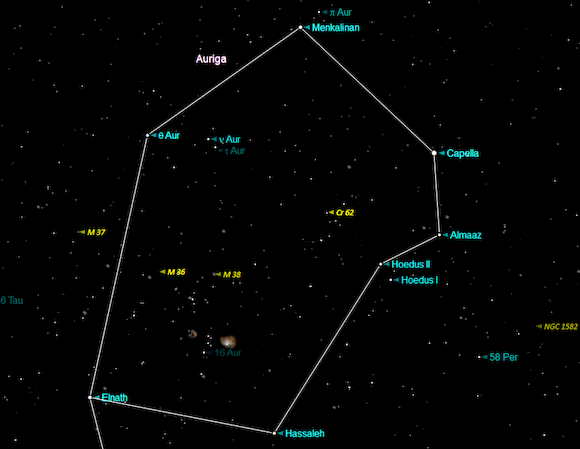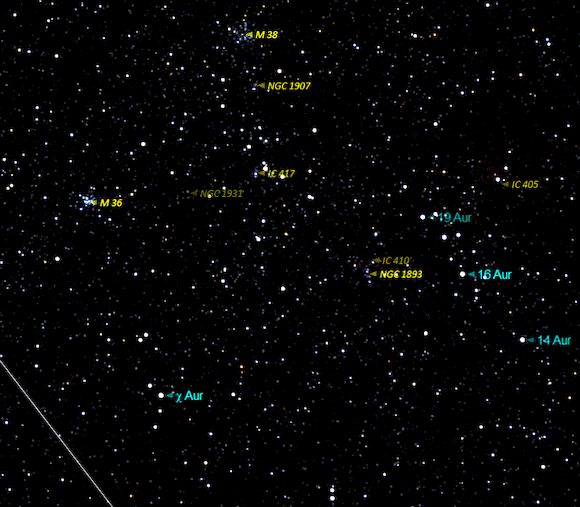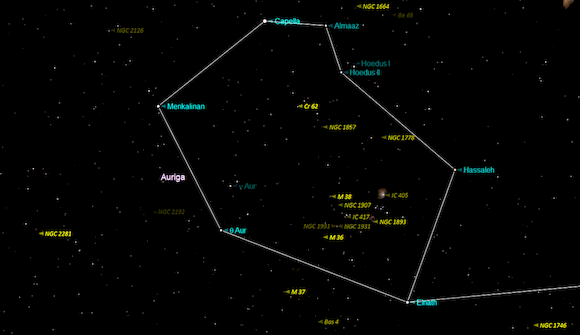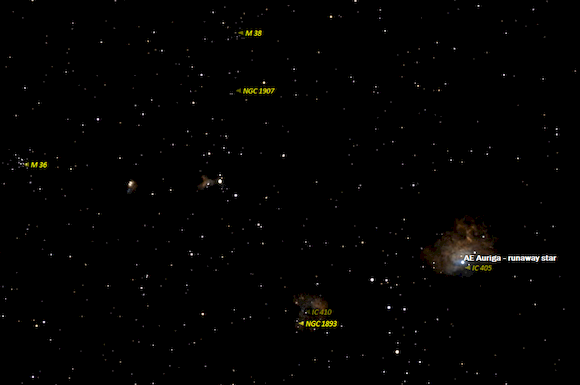As we head through the shortest month of the year, the magnificent jewelled celestial panorama ranged across the southern aspect is a joy to behold when skies are clear. At the heart of this starry tableau stands the mighty hunter; Orion, perhaps the most widely recognised constellation in the heavens. Bearing down on the hunter from the upper right, Taurus the bull faces Orion, its tail marked by the glorious Pleiades star cluster. Beneath Orion's feet, the timid hare Lepus, crouches; perhaps hiding from the hunter’s two hunting dogs, Canis Major and Canis Minor, dutifully following their master across the sky. Opposite Taurus, and following Orion are the twins of Gemini, but our destination is sited above these; Auriga, the charioteer.
Extending up, almost overhead, sits the outline of the charioteer; Auriga. On ancient star charts he is depicted grasping the reins of a chariot, whilst on his left arm are carried a goat and its two kids. Several mythology tales identify this constellation with Erechthonius, legendary king of Athens. Erechthonius was the son of Hephaestus, the god of fire (vulcan in Roman myth) but was raised by the goddess Athene who taught him many skills, including how to tame horses. He became the first person to harness four horses to a chariot, which earned him the admiration of Zeus and assured him a place among the stars.
Auriga contains the sixth-brightest star in the sky, Capella, a Roman name meaning ‘she-goat’, the goat in question according to Aratus, being Amaltheia, who suckled the infant Zeus along with the two kids she bore at the same time. The kids, also known by their Latin name of Haedi, are represented by the neighbouring stars Eta (Hoedus II) and Zeta (Hoedus I) Aurigae, Epsilon or Almaaz, is wrongly regarded as a 'third kid', but this doesn't fit the story.
At magnitude 0.06, Capella is the closest first magnitude star to the north celestial pole and from UK latitudes is circumpolar, never setting, arcing low to north horizon over the summer months but culminating high overhead during the winter. Capella lies around 43 light years away and is classed as a spectrum G8 binary giant. The two stars are separated by just 70 million miles, too close for telescopic observation. The primary component is around 13 times the diameter of our Sun, the secondary around 7 times. Several other smaller candidate companion stars also lie in the neighbourhood making Capella a multiple star system. Studies of Capella's annual proper motion through space suggests it closely matches that of the Taurus moving group associated with the Hyades star cluster, and it is possible Capella may be an outlying member.
Beta Aurigae lies opposite Capella at the top of the constellation. Menkalinan shines at a very respectable mag 1.9 and is a short period eclipsing binary, both componants being almost equal in size, just over 2.5 times the diameter of the Sun separated by just under 8 million miles!. An odd fact about Menkalinan is that it exhibits the same proper motion as Sirius, and is probably a member of a widely scattered stellar stream over 70 strong.
Of the stars which comprise the 'kids', the unofficial 'kid', epsilon or Almaaz, is of most interest. Recognised as one of the most remarkable eclipsing variable stars in the sky, epsilon has been the subject of numerous studies. The two components revolve around their common centre of gravity taking just over 27 years to do so (9883 days). The visible star; an class F supergiant perhaps 4-15 solar masses, is eclipsed by an unseen companion lasting 640- 730 days, the last eclipse being from 2009 - 2011. The unseen companion may be an elongated flattened disk of material /gas and dust, with a central hole. Epsilon lies around 2700 light years distant and shines at a variable magnitude of around +3.
the true kid members are eta and zeta. Eta or Hoedus II lies around 370 light years away and shines at mag 3.18 being over 500 times our sun's luminosity. Zeta (Hoedus I) or Sadatoni is also an eclipsing variable star comprising a relatively small blue star and a K type giant. The pair orbit about each other in 2.66yrs and are perhaps separated by 600 million miles. They are located around 1200 light years away.
Other stars on the main outline of Auriga are Theta (Mahasim) a spectrum B9 star of mag 2.65 approximately 110 light years distant. Theta is known as a 'silicon star' due to the abnormal strength of the element in its spectrum lines. Iota aurigae (Hassaleh) is a spectrum K II star around 350 light years distant with a mag of 2.67.
Greek astronomers regarded one star as being shared by Auriga and Taurus. On old star maps this star is shown as representing both the right foot of the charioteer and also the tip of the bull’s left horn. When the German astronomer Johan Bayer came to allocate Greek letters to the stars in the early 17th century he designated this star as both Gamma Aurigae and Beta Tauri. However, since the introduction of precise constellation boundaries in 1930, astronomers have assigned Elnath exclusively to Taurus as Beta Tauri and there is no longer a Gamma Aurigae. Hence, under the modern scheme, the bull has kept the tip of his horn but the luckless charioteer has lost his right foot!
With the Milky Way running through parts of Auriga, the group has many deep sky objects within it. The three brightest open clusters are M36, M37 and M38, all of which are visible in binoculars or a small telescope from semi dark skies, but a larger aperture is required to resolve individual stars.
Discovered in 1749 by Guillaume Le Gentil, M36 (NGC 1960) is the smallest and the most concentrated of the open clusters, being around 14 light years across. It is a young cluster comprised of approximately 60 stars, but only about 40 stars are visible in most amateur instruments. Most of these are B class stars with rapid rates of rotation. M36 lies at a distance of 3,900 light-years and has an overall magnitude of 6.0.
Discovered in 1764 by Charles Messier, M37 (NGC 2099) is larger than M36, containing around 150-200 stars at a distance of 4,200 light-years, making it the richest and at mag 5.6, brightest open cluster in Auriga. The cluster is approximately 200 million years old, older than M36. Many of the stars are A type stars. The heart of the cluster spans around 25 light years in space. It is a fine spectacle in medium scopes.
Like M36, M38 was discovered by Guillaume Le Gentil in 1749. At a distance of 3,900 light-years, M38 is the least concentrated of the three main open clusters in Auriga containing perhaps 100 members in a 25 light-year wide region. Unlike M36 or M37, M38 has a varied stellar population, mainly A and B type main sequence stars as well as a number of G type giant stars. One yellow-hued G type star is the brightest star in M38 at a magnitude of 7.9, which overall has a magnitude of 6.4. M38 is accompanied by NGC 1907, a smaller and dimmer cluster that lies half a degree SSW of M38 and at a distance of 4,400 light-years.
There are numerous star clusters located within the borders of Auriga, some associated with nebula. However, in most cases these are not apparent to the naked eye through a telescope without the use of filters. It is a different story through an imaging device however. Point a camera on a tracking device at Auriga for less than a minute and the charioteer takes on a whole different appearance. Other open clusters include NGC 2281, lying close to phi Aurigae, NGC 1664, which is close to eta Aurigae and the bright open cluster NGC 1893, accompanied by the faint nebula IC 410 (only visible with an Oxygen-III filter) This nebula is over 12000 light years distant, whereas the adjacent nebula; IC 405, the 'Flaming Star Nebula', is located just 1300-1500 light years away. It is located roughly midway between M38 and Iota Aurigae and may be 6-9 light years in extent.
The nebula is illuminated by an unusual very hot 'O type' star of 6th magnitude; AE aurigae. However, it would seem AE is just visiting as it is one of the 3 ‘runaway stars’ visible to observers, indeed the star seems to be moving outwards from the region of the Great Orion nebula and is perhaps an escaped member of the 'trapezium' cluster, ejected over 2.5 million years ago!
If you get the opportunity this winter (or spring, summer or autumn), do check out the charioteer, one of the northern hemisphere's finest constellations, illuminated by one of its brightest stars!
- Log in to post comments

